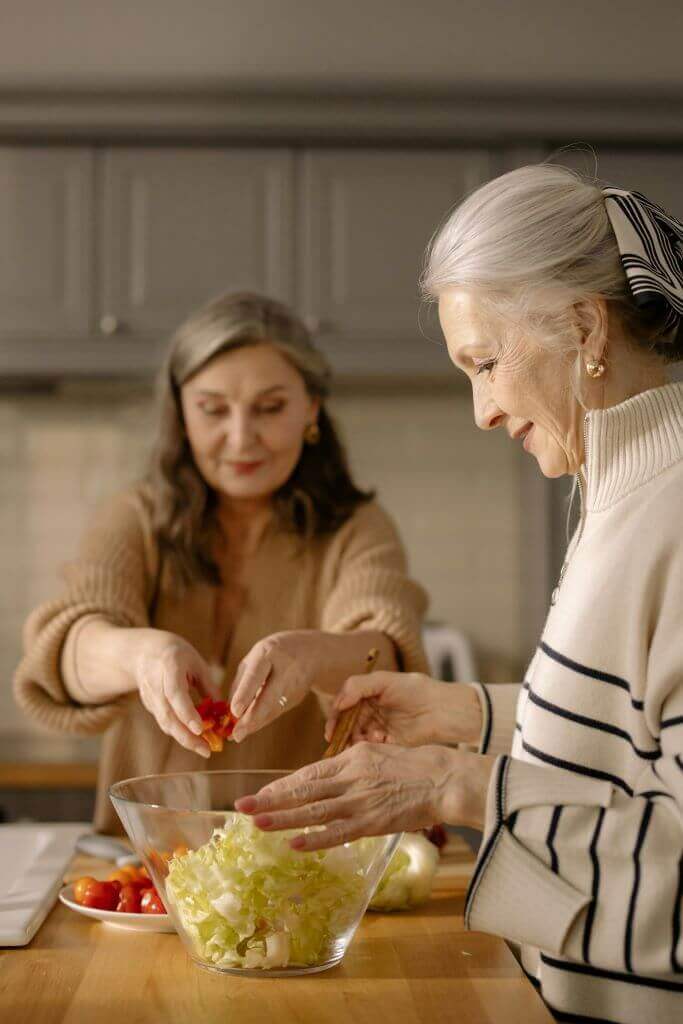Think of the challenges of old age. What comes immediately to mind? Alzheimer’s and other dementias, cardiovascular issues, type 2 diabetes and mobility impairment, most likely. What about nutrition? No? Well, that isn’t surprising. Poor nutrition is possibly the most underestimated problem that older people experience. Yet, healthy food is a critically important element of an overall healthy life.
Healthy nutrition helps to maintain the immune system, reduces the risk of toxin build-up and organ damage and promotes general well-being. Maintaining healthy nutrition is a challenge, however, especially when dealing with constantly changing dietary needs, preferences and restrictions.
According to a report by the National Center for Biotechnology Information (NCBI), malnutrition is a common problem among older adults, affecting up to 50% of hospital patients and up to 60% of those living in institutions for the elderly and infirm. Malnutrition in older adults is usually attributable to underlying illness, depression, use of certain drugs or being dependent on someone else for feeding.
Planning a Balanced and Varied Menu
The first step towards healthy food is a meal plan that covers all the food groups and provides adequate calories, protein, vitamins, minerals and fluids. The MyPlate Plan by the United States Department of Agriculture (USDA) is an invaluable age-adjustable tool to help with meal planning. In broad terms, it recommends filling half of the plate with fruits and vegetables, a quarter with whole grains and another quarter with lean protein sources. In addition, it suggests choosing low-fat or fat-free dairy products or alternatives and limiting added sugars, saturated fats and sodium.
It's also important to remember that some people may have difficulty chewing or swallowing certain foods, and some may have food allergies or intolerances. Others may have medical conditions that require inclusion or avoidance of certain foods. Whenever you have to consider exceptions, it’s best to consult a medical professional or dietician.
Keep it Fresh and Appealing
As far as possible, use simple and fresh ingredients. Although the term “global village” relates to a world connected by telecommunications and the internet, it can equally apply to the scale of global trade nowadays. Fresh products are now readily available no matter which season it is. From farm to table in 24 hours, from anywhere in the world, any time of the year. Fresh fruits and vegetables are much more versatile because their natural color and texture have not been compromised by the blanching process used in their frozen counterparts.
Many older people simply lose interest in eating, or experience various eating disorders or loss of senses. Using color, flavor and texture makes meals more appealing and appetizing. This helps stimulate the senses and appetite and can make food more enjoyable. Use only natural products for color and flavor, as synthetics may contain compounds that cause adverse side effects.
Modify Recipes and Methods for Older Adults
Every culture has its favorite dishes. Or traditional dishes, whether national or regional. And, of course, not to forget those recipes that have been handed down from mother to daughter for many generations. Sadly, many of these dishes may not be suitable for older people with various health conditions. However, a few modifications, sometimes only minor ones, might be all that’s required to put them back on the table.
Let’s look at some of these conditions and the changes we can make:
Diabetes. Reduce sugar or substitute with natural sweeteners such as honey or stevia. Note, though, that stevia, as a finished product, may contain fillers that are not necessarily natural. Given all the speculation about the harmful effects of synthetic sweeteners, it’s best to avoid them altogether.
High Blood Pressure. Limit the use of salt or use herbs, spices or lemon juice instead. Increase the use of potassium-rich foods such as bananas, potatoes and tomatoes. You should also limit alcohol and caffeine.
High Cholesterol. Avoid saturated fat. Use lean protein sources such as white fish, poultry and pulses. Try also to increase the amount of soluble fiber in the diet.
Osteoporosis: Increase the intake of calcium or use calcium-fortified products. You should also include foods rich in vitamin D, such as eggs, mushrooms or salmon and protein sources such as meat, poultry and soy.
Involve Seniors in Meal Preparation and Cooking
General health and well-being involve more than just tasty, healthy food. Involving your patient in meal preparation and cooking can help them feel more independent, engaged and valued. There is also a strong psychological effect when people enjoy the fruits of their own labor.
When you create a meal plan, ask your patient what their favorite dishes are and whether there are any foods that they don’t like. Ask them about any special dishes for specific occasions or general suggestions for the menu. This fosters a feeling of ownership and accomplishment.
Ensure that your patient performs only those tasks that are safe and within any physical limits they may have. If you’re in any doubt, avoid using sharp or pointed kitchen utensils. They can wash and peel fruits and vegetables, measure or mix ingredients, set the table or serve the food.
If circumstances permit, try to share the meal with your patient. Allow them to talk about the food. Invite their feedback and suggestions for improvements or variations and encourage them to try new foods or flavors. After the meal, compliment your patient on the meal and thank them for contributing to its preparation.
Strategies for Saving Time and Money
Preparing tasty and healthy food usually requires significant time and effort, particularly when made from scratch for every meal. Meals are also usually a lot more expensive if you frequently buy ingredients or cook meals in small quantities. A few simple strategies will save you a lot of time and money, help you reduce waste and avoid unnecessary stress.
Pantry staples. Stock up on a few pantry staples with a long shelf life that can be used to make various different dishes. A typical shopping list would include:
· canned products such as tomato sauce or paste, tuna and sardines, various fruits and vegetables and some jams or preserves.
· a selection of dried foods like pulses, fruits and nuts, pasta and rice, cereals, crackers and dry seasonings
· condiments, sauces and flavorings like vinegar, soy sauce, mustard and ketchup amongst others.
Foods that contain oils are prone to becoming rancid because the fat oxidizes. Avoid stocking more of these than you can use within a few weeks or a month or two. It’s also a good idea to store them in a cool, dark place as heat and light speed up the oxidation process.
Frozen Foods. Always have some frozen foods on hand for when you unexpectedly run out of fresh ingredients. Keep a few portions of frozen meat and fish, some fruits and vegetables and some prepared meals such as pizza or lasagna, frozen waffles or pancakes and frozen soups or stews. This should be a backup rather than a staple. Of course, occasionally, we can buy large quantities of food at significant discounts, and then it makes sense to freeze the surplus.
Meal delivery services. You may occasionally want to take a break from cooking or indulge in a favorite take-out. Some meal delivery services offer ready-made meals tailored to older people’s dietary needs and preferences. Many of them deliver fresh or frozen meals low in sodium, sugar and fat and high in protein, fiber and vitamins. We don’t recommend doing this too frequently, but sometimes a burger, pizza or fried chicken meal just seems to make everything right again for a while.
Catering for Special Needs
Occasionally, caregivers may have to deal with challenges like chewing and swallowing difficulties, nutrient deficiencies unrelated to the patient’s diet or certain medical conditions. In these cases, you may have to use nutritional supplements, tube-feeding preparations or thickeners. For expert advice and a wide range of the best products at the best prices, contact our experienced team at LL Medico. We have been supporting and assisting caregivers for more than 25 years. Call (855) 422-4556 or email support@llmedico.com.
Conclusion
Nutrition is one of the cornerstones of good health and something we should pay attention to throughout our lives. However, as we get older, it becomes much more important because of the various health issues we start to experience. We hope that we have introduced you to a few basic strategies that may help you ensure that your loved one or patient gets all the nutrients they need.
The famous chef Julia Child once said, “The only real stumbling block is fear of failure. In cooking you’ve got to have a what-the-hell attitude.” So, don’t be afraid to try new things, experiment with different ingredients and recipes, and enjoy creating healthy and delicious meals for your elderly loved one. Bon appétit!







 855-422-4556
855-422-4556 Chat
Chat E-Mail
E-Mail Monday - Friday 9:00AM to 5:00PM EST
Monday - Friday 9:00AM to 5:00PM EST





 Shopping With LL Medico
Shopping With LL Medico
 855-422-4556
855-422-4556